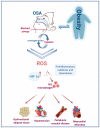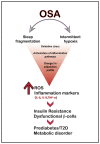Investigating the Relationship between Obstructive Sleep Apnoea, Inflammation and Cardio-Metabolic Diseases
- PMID: 37047780
- PMCID: PMC10095553
- DOI: 10.3390/ijms24076807
Investigating the Relationship between Obstructive Sleep Apnoea, Inflammation and Cardio-Metabolic Diseases
Abstract
Obstructive sleep apnoea (OSA) is a prevalent underdiagnosed disorder whose incidence increases with age and weight. Uniquely characterised by frequent breathing interruptions during sleep-known as intermittent hypoxia (IH)-OSA disrupts the circadian rhythm. Patients with OSA have repeated episodes of hypoxia and reoxygenation, leading to systemic consequences. OSA consequences range from apparent symptoms like excessive daytime sleepiness, neurocognitive deterioration and decreased quality of life to pathological complications characterised by elevated biomarkers linked to endocrine-metabolic and cardiovascular changes. OSA is a well-recognized risk factor for cardiovascular and cerebrovascular diseases. Furthermore, OSA is linked to other conditions that worsen cardiovascular outcomes, such as obesity. The relationship between OSA and obesity is complex and reciprocal, involving interaction between biological and lifestyle factors. The pathogenesis of both OSA and obesity involve oxidative stress, inflammation and metabolic dysregulation. The current medical practice uses continuous positive airway pressure (CPAP) as the gold standard tool to manage OSA. It has been shown to improve symptoms and cardiac function, reduce cardiovascular risk and normalise biomarkers. Nonetheless, a full understanding of the factors involved in the deleterious effects of OSA and the best methods to eliminate their occurrence are still poorly understood. In this review, we present the factors and evidence linking OSA to increased risk of cardiovascular conditions.
Keywords: CPAP; cardiovascular disease; hypoxia-inducible factor-1; inflammation; obstructive sleep apnoea; reactive oxygen species.
Conflict of interest statement
The authors declare no conflict of interest.
Figures


Similar articles
-
Vascular responses to hypoxia are not impaired in obstructive sleep apnoea patients free of overt cardiovascular disease.Exp Physiol. 2019 Apr;104(4):580-600. doi: 10.1113/EP086845. Epub 2019 Feb 27. Exp Physiol. 2019. PMID: 30697840
-
Clinical perspective of obstructive sleep apnea-induced cardiovascular complications.Antioxid Redox Signal. 2007 Jun;9(6):701-10. doi: 10.1089/ars.2007.1558. Antioxid Redox Signal. 2007. PMID: 17511585 Review.
-
Obstructive sleep apnoea and cardiovascular consequences: Pathophysiological mechanisms.Arch Cardiovasc Dis. 2020 May;113(5):350-358. doi: 10.1016/j.acvd.2020.01.003. Epub 2020 Mar 26. Arch Cardiovasc Dis. 2020. PMID: 32224049 Review.
-
Sleep-disordered breathing, type 2 diabetes and the metabolic syndrome.Chron Respir Dis. 2014 Nov;11(4):257-75. doi: 10.1177/1479972314552806. Epub 2014 Oct 3. Chron Respir Dis. 2014. PMID: 25281562 Review.
-
Obstructive sleep apnoea and obesity.Aust Fam Physician. 2017;46(7):460-463. Aust Fam Physician. 2017. PMID: 28697288
Cited by
-
Gender Differences in Insulin Resistance: New Knowledge and Perspectives.Curr Issues Mol Biol. 2023 Sep 27;45(10):7845-7861. doi: 10.3390/cimb45100496. Curr Issues Mol Biol. 2023. PMID: 37886939 Free PMC article. Review.
-
Effect of norepinephrine reuptake inhibitors combined with antimuscarinic agents vs monotherapy for OSA: a systematic review and meta-analysis.J Clin Sleep Med. 2024 Aug 1;20(8):1363-1372. doi: 10.5664/jcsm.11130. J Clin Sleep Med. 2024. PMID: 38494994 Free PMC article.
-
Exploring the pharmacological mechanisms for alleviating OSA: Adenosine A2A receptor downregulation of the PI3K/Akt/HIF‑1 pathway (Review).Biomed Rep. 2024 Nov 28;22(2):21. doi: 10.3892/br.2024.1899. eCollection 2025 Feb. Biomed Rep. 2024. PMID: 39720297 Free PMC article. Review.
-
Effects of Metabolic Factors on Left Ventricular Diastolic Function in Patients with Obstructive Sleep Apnea.Nat Sci Sleep. 2025 Jan 10;17:43-53. doi: 10.2147/NSS.S497970. eCollection 2025. Nat Sci Sleep. 2025. PMID: 39810795 Free PMC article.
-
NLRP3 Inflammasome Triggers Inflammation of Obstructive Sleep Apnea.Curr Mol Med. 2025;25(5):522-536. doi: 10.2174/0115665240294605240426123650. Curr Mol Med. 2025. PMID: 38757326 Review.
References
-
- Andayeshgar B., Janatolmakan M., Soroush A., Azizi S.M., Khatony A. The prevalence of obstructive sleep apnea in patients with type 2 diabetes: A systematic review and meta-analysis. Sleep Sci. Pract. 2022;6:6. doi: 10.1186/s41606-022-00074-w. - DOI
-
- Benjafield A.V., Ayas N.T., Eastwood P.R., Heinzer R., Ip M.S.M., Morrell M.J., Nunez C.M., Patel S.R., Penzel T., Pépin J.L., et al. Estimation of the global prevalence and burden of obstructive sleep apnoea: A literature-based analysis. Lancet Respir. Med. 2019;7:687–698. doi: 10.1016/S2213-2600(19)30198-5. - DOI - PMC - PubMed
-
- Ouayoun M.C., Chabolle F., De Vito A., Heiser C., Paramasivan V.K., Rabelo F.A.W., Rotenberg B., Suurna M.V. International consensus (ICON) on the ENT role in diagnosis of obstructive sleep apnea syndrome. Eur. Ann. Otorhinolaryngol. Head Neck Dis. 2018;135:S3–S6. doi: 10.1016/j.anorl.2017.12.012. - DOI - PubMed
Publication types
MeSH terms
LinkOut - more resources
Full Text Sources
Medical

